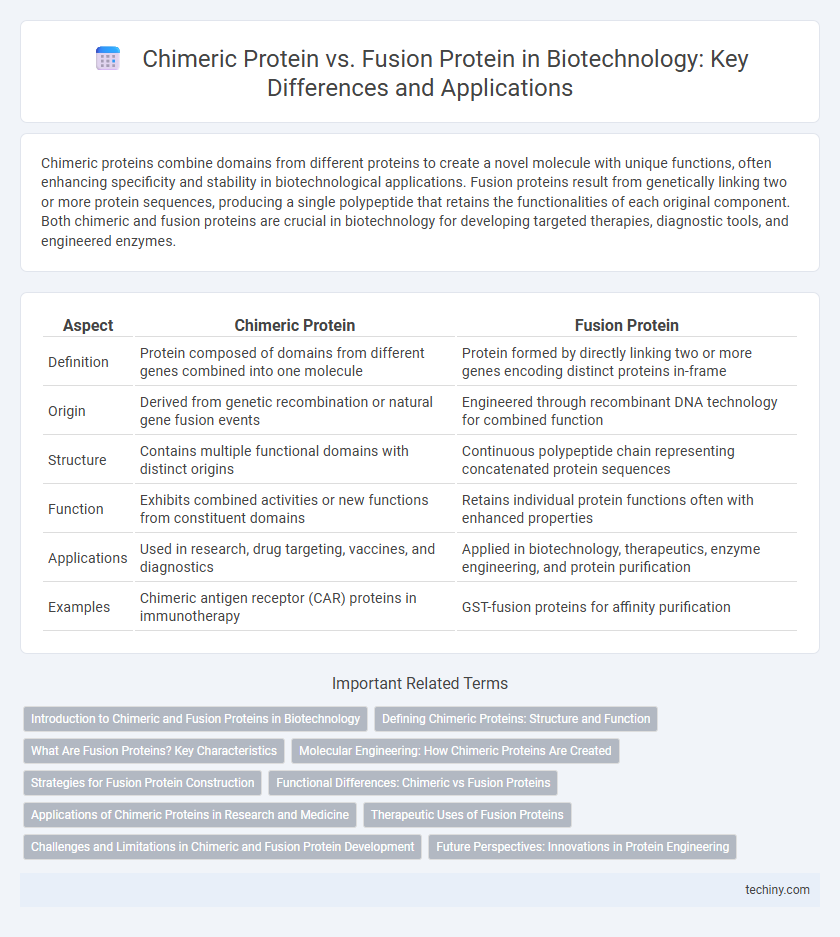Chimeric proteins combine domains from different proteins to create a novel molecule with unique functions, often enhancing specificity and stability in biotechnological applications. Fusion proteins result from genetically linking two or more protein sequences, producing a single polypeptide that retains the functionalities of each original component. Both chimeric and fusion proteins are crucial in biotechnology for developing targeted therapies, diagnostic tools, and engineered enzymes.
Table of Comparison
| Aspect | Chimeric Protein | Fusion Protein |
|---|---|---|
| Definition | Protein composed of domains from different genes combined into one molecule | Protein formed by directly linking two or more genes encoding distinct proteins in-frame |
| Origin | Derived from genetic recombination or natural gene fusion events | Engineered through recombinant DNA technology for combined function |
| Structure | Contains multiple functional domains with distinct origins | Continuous polypeptide chain representing concatenated protein sequences |
| Function | Exhibits combined activities or new functions from constituent domains | Retains individual protein functions often with enhanced properties |
| Applications | Used in research, drug targeting, vaccines, and diagnostics | Applied in biotechnology, therapeutics, enzyme engineering, and protein purification |
| Examples | Chimeric antigen receptor (CAR) proteins in immunotherapy | GST-fusion proteins for affinity purification |
Introduction to Chimeric and Fusion Proteins in Biotechnology
Chimeric proteins are engineered molecules composed of segments derived from different genes, designed to combine functional properties from each source to optimize biological activity. Fusion proteins result from the direct joining of two or more protein-coding sequences, producing a single polypeptide with combined functionalities for therapeutic or diagnostic applications. Both chimeric and fusion proteins serve as crucial tools in biotechnology, enabling targeted drug delivery, enhanced enzymatic activity, and innovative biomolecular research.
Defining Chimeric Proteins: Structure and Function
Chimeric proteins are engineered molecules composed of structural domains from two or more different proteins, enabling the combination of distinct functional properties into a single polypeptide chain. These proteins often exhibit novel biological activities or enhanced specificity by integrating binding sites or enzymatic functions from disparate sources, making them valuable tools in therapeutic development and molecular biology research. The design of chimeric proteins leverages domain modularity to optimize interactions at the cellular or molecular level, facilitating targeted interventions in disease or metabolic processes.
What Are Fusion Proteins? Key Characteristics
Fusion proteins are engineered molecules created by joining two or more genes coding for separate proteins into a single open reading frame, resulting in a multifunctional protein. Key characteristics include the retention of functional domains from each parent protein, enabling combined or novel activities within one polypeptide chain. This design facilitates targeted therapeutic applications, improved protein stability, and streamlined purification processes in biotechnology.
Molecular Engineering: How Chimeric Proteins Are Created
Chimeric proteins are engineered by combining genetic sequences from two or more distinct proteins, resulting in a novel molecule with combined functional properties. Molecular engineering techniques such as recombinant DNA technology and site-directed mutagenesis allow precise assembly of these hybrid proteins, facilitating the study of domain interactions and creation of multifunctional biomolecules. Fusion proteins, by contrast, typically involve the direct joining of full-length protein sequences without extensive domain remodeling, highlighting the tailored complexity achievable through chimeric protein synthesis.
Strategies for Fusion Protein Construction
Fusion protein construction involves combining domains from different proteins through genetic engineering techniques such as overlap extension PCR and restriction enzyme cloning, enabling tailored functionality. Chimeric proteins are designed by merging similar functional parts often from homologous proteins, while fusion proteins typically link distinct functional domains from diverse sources to create multifunctional molecules with optimized biological activity. Strategies emphasize selecting compatible linkers and ensuring proper folding to maintain each domain's activity within the fusion construct.
Functional Differences: Chimeric vs Fusion Proteins
Chimeric proteins combine domains from different proteins to create novel functions by merging distinct biological activities, while fusion proteins join two or more proteins in a single polypeptide chain, often enhancing stability or enabling simultaneous functionality. Chimeric proteins typically exhibit unique, emergent properties not present in the original molecules, whereas fusion proteins maintain the individual functions of each component within a linked construct. Functional differences arise as chimeric proteins can interact with distinct molecular partners, whereas fusion proteins streamline processes by co-localizing activities without fundamentally altering each domain's function.
Applications of Chimeric Proteins in Research and Medicine
Chimeric proteins serve as powerful tools in biotechnology by combining functional domains from different proteins to create novel molecules with tailored properties. Their applications in research include probing cellular pathways, engineering biosensors, and developing targeted therapies such as chimeric antigen receptor (CAR) T cells in cancer immunotherapy. In medicine, chimeric proteins facilitate drug delivery, enhance vaccine efficacy, and enable precision diagnostics, advancing personalized treatment strategies.
Therapeutic Uses of Fusion Proteins
Fusion proteins, engineered by combining two or more protein domains with distinct functions, are extensively used in therapeutic applications such as targeted cancer treatments and autoimmune disease management. These proteins enhance efficacy by improving specificity, stability, and half-life, exemplified by biologics like Enbrel for rheumatoid arthritis and fusion toxins targeting malignant cells. The ability to design fusion proteins with tailored properties accelerates the development of novel therapeutics with reduced immunogenicity and enhanced delivery mechanisms.
Challenges and Limitations in Chimeric and Fusion Protein Development
Chimeric and fusion protein development faces challenges such as protein misfolding and instability that compromise biological function. Immunogenicity posed by novel epitopes often triggers adverse immune responses, limiting therapeutic applications. Additionally, achieving efficient expression and proper folding in host systems remains a significant limitation in scalable production.
Future Perspectives: Innovations in Protein Engineering
Advancements in protein engineering are driving the development of chimeric and fusion proteins with enhanced therapeutic potential and tailored functionalities. Emerging techniques such as CRISPR-based genome editing and machine learning-guided design enable precise modification of protein domains to optimize stability, specificity, and efficacy. Future innovations are expected to facilitate customizable multi-functional proteins for applications in targeted drug delivery, diagnostics, and synthetic biology.
Chimeric protein vs Fusion protein Infographic

 techiny.com
techiny.com